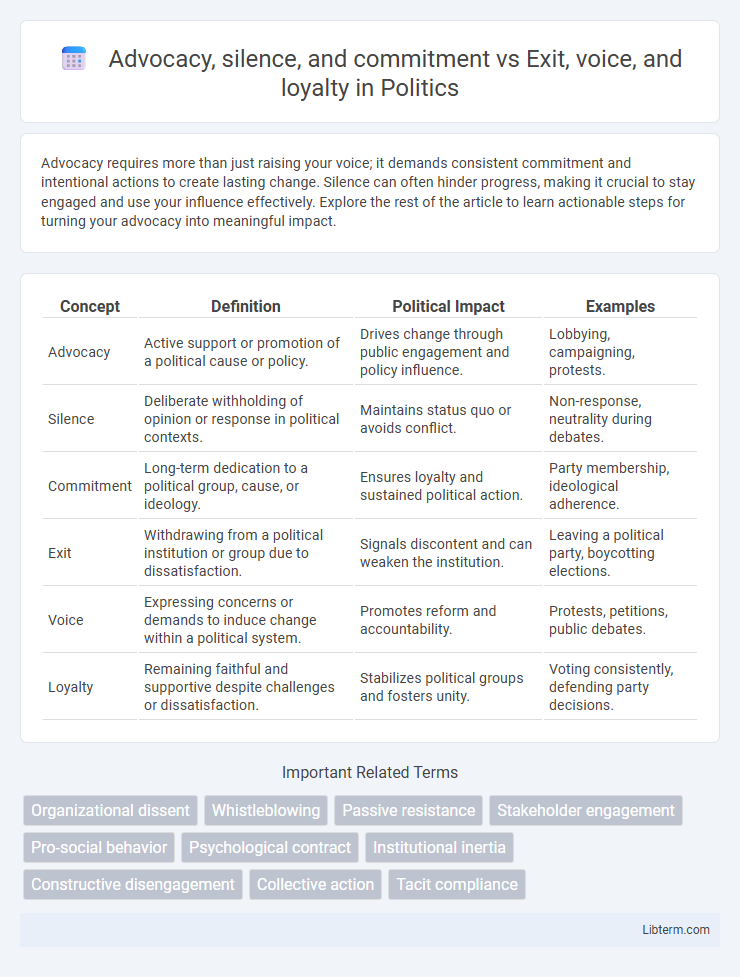Advocacy requires more than just raising your voice; it demands consistent commitment and intentional actions to create lasting change. Silence can often hinder progress, making it crucial to stay engaged and use your influence effectively. Explore the rest of the article to learn actionable steps for turning your advocacy into meaningful impact.
Table of Comparison
| Concept | Definition | Political Impact | Examples |
|---|---|---|---|
| Advocacy | Active support or promotion of a political cause or policy. | Drives change through public engagement and policy influence. | Lobbying, campaigning, protests. |
| Silence | Deliberate withholding of opinion or response in political contexts. | Maintains status quo or avoids conflict. | Non-response, neutrality during debates. |
| Commitment | Long-term dedication to a political group, cause, or ideology. | Ensures loyalty and sustained political action. | Party membership, ideological adherence. |
| Exit | Withdrawing from a political institution or group due to dissatisfaction. | Signals discontent and can weaken the institution. | Leaving a political party, boycotting elections. |
| Voice | Expressing concerns or demands to induce change within a political system. | Promotes reform and accountability. | Protests, petitions, public debates. |
| Loyalty | Remaining faithful and supportive despite challenges or dissatisfaction. | Stabilizes political groups and fosters unity. | Voting consistently, defending party decisions. |
Understanding Advocacy and Silence in Organizations
Advocacy in organizations involves actively promoting change and expressing concerns to improve processes and culture, while silence represents the choice to withhold feedback due to fear, indifference, or perceived futility. Understanding the dynamics between advocacy and silence reveals how employee commitment influences organizational responsiveness and innovation. Contrasted with Hirschman's framework of Exit, Voice, and Loyalty, advocacy aligns with "voice," signaling constructive engagement, whereas silence may precede exit or reflect passive loyalty.
The Dynamics of Commitment: Staying Versus Leaving
The dynamics of commitment in organizations hinge on the balance between advocacy, silence, and commitment versus exit, voice, and loyalty. Advocacy reflects proactive engagement to improve conditions, while silence indicates passive acceptance or withdrawal without leaving. Exit represents physical departure, voice denotes expressing concerns or seeking change, and loyalty involves staying despite dissatisfaction, revealing complex emotional and strategic decisions when individuals choose to stay or leave.
Hirschman’s Exit, Voice, and Loyalty Framework Explained
Hirschman's Exit, Voice, and Loyalty framework analyzes how individuals respond to dissatisfaction in organizations or states, emphasizing exit (leaving), voice (expressing concerns), and loyalty (commitment) as key reactions. Advocacy aligns with voice by promoting active engagement and change through communication, whereas silence can signal passive loyalty or disengagement, affecting organizational dynamics. Understanding these responses aids in interpreting behavior patterns in institutions, markets, and social movements, optimizing strategies for conflict resolution and retention.
Advocacy as a Form of Voice: Speaking Up for Change
Advocacy as a form of voice involves actively expressing concerns and championing change within organizations or communities to drive improvement and accountability. Unlike silence, which implies passive acceptance, advocacy encourages transparent communication and sustained commitment to reform. This proactive stance distinguishes itself from exit, where individuals leave the situation, and loyalty, which may prioritize conformity over change.
The Risks and Rewards of Organizational Silence
Organizational silence poses significant risks, including reduced innovation, low employee engagement, and the perpetuation of harmful practices, while advocacy and commitment encourage open communication and proactive problem-solving. Choosing silence over voice may protect individuals in the short term but increases the likelihood of systemic failures and diminished trust within the organization. Balancing exit, voice, and loyalty involves managing these dynamics to foster a culture where employees feel safe to express concerns, ultimately enhancing organizational resilience and long-term success.
Comparing Advocacy and Exit Strategies
Advocacy strategies emphasize active engagement and commitment to improving an organization from within, leveraging voice to influence positive change and sustain loyalty. Exit strategies involve withdrawing support or leaving the organization entirely when dissatisfaction surpasses the perceived value of engagement. Comparing both reveals advocacy fosters long-term organizational resilience through constructive dialogue, while exit reflects a critical loss of member investment and signals urgent need for systemic reform.
The Role of Loyalty in Navigating Workplace Challenges
Loyalty in the workplace serves as a critical factor in balancing exit and voice strategies, fostering employee commitment and advocacy while mitigating silence and disengagement. Employees demonstrating loyalty tend to advocate for organizational improvement rather than exit, channeling their voice to influence positive change and strengthen the workplace culture. This committed stance not only enhances job satisfaction but also supports resilience against challenges by promoting constructive dialogue and sustained dedication.
Balancing Voice and Silence: When to Speak, When to Listen
Balancing voice and silence requires discerning when advocacy drives positive change and when silent observation preserves relationships and insights. Commitment fuels active engagement and voice, while strategic silence often enhances understanding and trust in complex social dynamics. Recognizing moments to exit, speak out, or listen attentively optimizes outcomes in both personal and organizational contexts.
Commitment Versus Exit: Factors That Influence Decision-Making
Commitment versus exit in decision-making involves evaluating emotional attachment, perceived costs, and potential outcomes that influence whether individuals remain engaged or choose to leave. Factors such as trust, organizational loyalty, and belief in future improvements strengthen commitment, while dissatisfaction, lack of alternatives, and unmet expectations drive the exit option. Understanding these dynamics enables leaders to foster stronger advocacy and reduce silence, enhancing overall engagement and retention.
Building a Culture of Healthy Advocacy and Productive Dissent
Building a culture of healthy advocacy and productive dissent involves encouraging employees to voice concerns and ideas openly without fear of reprisal, fostering commitment to organizational values while addressing issues constructively. Emphasizing advocacy over silence ensures that diverse perspectives influence decision-making, reducing the risks associated with passive acceptance or disengagement. Balancing exit, voice, and loyalty dynamics enhances organizational resilience by promoting transparency, accountability, and continuous improvement through collaborative dialogue.
Advocacy, silence, and commitment Infographic

 libterm.com
libterm.com